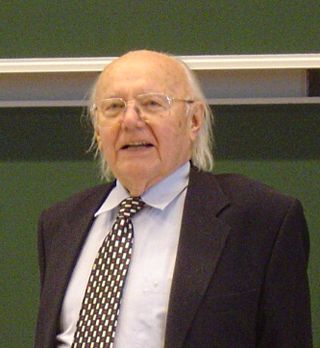A distributed system is a system whose components are located on different networked computers, which communicate and coordinate their actions by passing messages to one another. Distributed computing is a field of computer science that studies distributed systems.

Artificial neural networks (ANNs), usually simply called neural networks (NNs) or neural nets, are computing systems inspired by the biological neural networks that constitute animal brains.

Machine learning (ML) is a field devoted to understanding and building methods that let machines "learn" – that is, methods that leverage data to improve computer performance on some set of tasks.
A hypnic jerk, hypnagogic jerk, sleep start, sleep twitch, myoclonic jerk, or night start is a brief and sudden involuntary contraction of the muscles of the body which occurs when a person is beginning to fall asleep, often causing the person to jump and awaken suddenly for a moment. Hypnic jerks are one form of involuntary muscle twitches called myoclonus.
Springer Science+Business Media, commonly known as Springer, is a German multinational publishing company of books, e-books and peer-reviewed journals in science, humanities, technical and medical (STM) publishing.

Rodolfo Llinás Riascos is a Colombian and American neuroscientist. He is currently the Thomas and Suzanne Murphy Professor of Neuroscience and Chairman Emeritus of the Department of Physiology & Neuroscience at the NYU School of Medicine. Llinás has published over 800 scientific articles.

Heinz-Otto Peitgen is a German mathematician and was President of Jacobs University from January 1, 2013 to December 31, 2013. Peitgen contributed to the study of fractals, chaos theory, and medical image computing, as well as helping to introduce fractals to the broader public.
Fundamenta Mathematicae is a peer-reviewed scientific journal of mathematics with a special focus on the foundations of mathematics, concentrating on set theory, mathematical logic, topology and its interactions with algebra, and dynamical systems.

Titin is a protein that in humans is encoded by the TTN gene. Titin is a giant protein, greater than 1 µm in length, that functions as a molecular spring that is responsible for the passive elasticity of muscle. It comprises 244 individually folded protein domains connected by unstructured peptide sequences. These domains unfold when the protein is stretched and refold when the tension is removed.

A recurrent neural network (RNN) is a class of artificial neural networks where connections between nodes can create a cycle, allowing output from some nodes to affect subsequent input to the same nodes. This allows it to exhibit temporal dynamic behavior. Derived from feedforward neural networks, RNNs can use their internal state (memory) to process variable length sequences of inputs. This makes them applicable to tasks such as unsegmented, connected handwriting recognition or speech recognition. Recurrent neural networks are theoretically Turing complete and can run arbitrary programs to process arbitrary sequences of inputs.

Clorgiline (INN), or clorgyline (BAN), is a monoamine oxidase inhibitor (MAOI) structurally related to pargyline which is described as an antidepressant. Specifically, it is an irreversible and selective inhibitor of monoamine oxidase A (MAO-A). Clorgiline was never marketed, but it has found use in scientific research. It has been found to bind with high affinity to the σ1 receptor (Ki = 3.2 nM) and with very high affinity to the I2 imidazoline receptor (Ki = 40 pM).
Congenital myopathy is a very broad term for any muscle disorder present at birth. This defect primarily affects skeletal muscle fibres and causes muscular weakness and/or hypotonia. Congenital myopathies account for one of the top neuromuscular disorders in the world today, comprising approximately 6 in 100,000 live births every year. As a whole, congenital myopathies can be broadly classified as follows:

Heinz Zemanek was an Austrian computer pioneer who led the development, from 1954 to 1958, of one of the first complete transistorised computers on the European continent. The computer was nicknamed Mailüfterl — Viennese for "May breeze" — in reference to Whirlwind, a computer developed at MIT between 1945 and 1951.
Applied Physics A: Materials Science and Processing is a peer-reviewed scientific journal that is published monthly by Springer Science+Business Media. The editor-in-chief is Thomas Lippert. This publication is complemented by Applied Physics B .

Applied Physics B: Lasers & Optics is a peer-reviewed scientific journal published by Springer Science+Business Media. The editor-in-chief is Jacob Mackenzie. Topical coverage includes laser physics, optical & laser materials, linear optics, nonlinear optics, quantum optics, and photonic devices. Interest also includes laser spectroscopy pertaining to atoms, molecules, and clusters. The journal publishes original research articles, invited reviews, and rapid communications.

Cybernetics is a wide-ranging field concerned with circular causal processes such as feedback. Norbert Wiener named the field after an example of circular causal feedback—that of steering a ship where the helmsman adjusts their steering in response to the effect it is observed as having, enabling a steady course to be maintained amongst disturbances such as cross-winds or the tide.

The Bulletin of Volcanology is a peer reviewed scientific journal that is published ten times per year by Springer Science+Business Media. It is the official journal of the International Association of Volcanology and Chemistry of the Earth's Interior (IAVCEI). The focus of the journal is volcanoes, volcanic products, eruptive behavior, and volcanic hazards. The Executive Editor is James DL White.
Julius Springer was a German publisher who founded the academic publishing house Springer Science+Business Media.
Graphs and Combinatorics is a peer-reviewed academic journal in graph theory, combinatorics, and discrete geometry published by Springer Japan. Its editor-in-chief is Katsuhiro Ota of Keio University.

Heinz Wanner is a Swiss geographer and climate researcher. He is a professor emeritus and works at the Oeschger Centre for Climate Change Research of the University of Bern.











